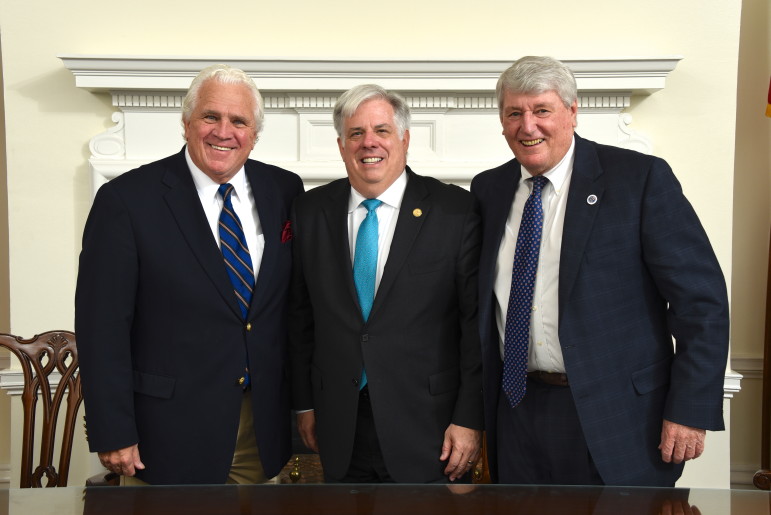Hogan’s bipartisan success – a lesson for Democrats
Senate President Mike Miller, Gov. Larry Hogan House Speaker Michael Busch.
By Greg Kline
For MarylandReporter.com
The passage of the fiscal 2017 budget by the Maryland General Assembly is without question an overwhelming victory for Governor Hogan.
The broad bipartisan support in both chambers for the governor’s budget, largely unchanged by state legislators, is a testament to the success of Governor Hogan’s collaborative approach to state spending.The passage of the fiscal 2017 budget by the Maryland General Assembly is without question an overwhelming victory for Governor Hogan.
It stands in stark contrast to the plethora of efforts and bills presented by Democrats in the General Assembly seeking to undermine the governor, the Board of Public Works and in general to gather more and more power to the legislature itself.
The success of the budget’s early passage also disproves the critics of Governor Hogan, who insist that he often acts in a partisan manner. The reality, of course, is that Maryland Democrats have shown that they only occasionally act in a bipartisan manner.
The fiscal 2017 Maryland operating budget includes over $42 billion in spending. The final plan, approved by wide margins in both the State Senate in the Maryland House of Delegates, largely follows the outlines that Governor Hogan proposed before the session began.
Democratic leaders made a few alterations to the Governor’s original proposal but in terms of the overall scope of spending all they could manage is to nibble at the edges.
Fencing off $80 million
The most notable amendment to the governor’s budget is an $80 million set aside, money taken from the governor’s appropriation to the state’s Rainy Day Fund. The legislature intends that the governor spend this $80 million, an amount equal to .2% of the state operating budget, in a manner that they prescribe.
However, the governor is not bound to spend this money at all let alone as directed by the legislature. Moreover, state Democratic leaders have touted an additional $30 million of spending for education in Baltimore and to demolish vacant homes in the city. Again though, these appropriations represent a small fraction of overall state spending.
Public-sector unions touted their greatest victory in this budget as an expenditure of $1.2 million to save the jobs of 50 workers at the Springfield Hospital Center. Union leaders also noted an appropriation of $900,000 to avert layoff of state employees it to other facilities. The fact that public unions trumpet little over $2 million in state spending as their greatest legislative accomplishments for the session speak volumes about how far Governor Hogan has come in reining in state spending.
Of course the success of the state budget comes after Governor Hogan submitted a supplemental budget allocating funds for Baltimore City and for the Prince George’s County Hospital Center, among other items.
Maintaining priorities without more spending
The governor sought to work with legislative leaders and to address their concerns in a way that allowed the budget to proceed without materially altering either the governor’s priorities or significantly adding to the overall amount of state spending.
These compromises and the subsequent overwhelming support for the governor’s budget in the state legislature is arguably the greatest triumph of bipartisanship to date for the Hogan administration.
While the governor was working with state legislators to overcome their concerns about state spending, Democratic leaders have been assiduously working to pass a series of bills intended to diminish the governor’s authority and undermine his prerogatives.
Diminishing the governor’s authority
These bills have included efforts to radically alter the way state transportation projects are prioritized, undermine the authority and public disclosure of spending facilitated by the Board of Public Works and at seemingly every turn to remove the broad appointment powers Maryland governors have enjoyed for decades.
In fact, while the governor worked hard to pass a bipartisan budget early before the end of session, legislative Democrats are working to beat the clock to pass outrageous measures they know the governor will veto so that they can override those anticipated vetoes before the end of the legislative session.
To accomplish this naked partisan power grab Democratic legislative leaders have taken votes on bills without public hearings, severely limited debate on important public matters, and generally rewritten the rules and customs of the General Assembly to accomplish their ends.
It remains to be seen whether these cynical efforts on behalf of legislative Democrats will be successful. Even more time will tell at what cost to the passage of other legislation these outrageously partisan measures will incur.
But what should be beyond question at this point in the 2016 legislative session is that bipartisanship is a tactic fully embraced by Governor Hogan and nearly universally dismissed by Maryland Democrats.
This contrast does not appear to have been lost on the voters who continue to reward the governor’s approach with wide bipartisan public support.

MarylandReporter.com is a daily news website produced by journalists committed to making state government as open, transparent, accountable and responsive as possible – in deed, not just in promise. We believe the people who pay for this government are entitled to have their money spent in an efficient and effective way, and that they are entitled to keep as much of their hard-earned dollars as they possibly can.

